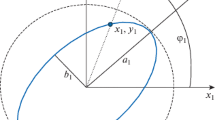This paper describes a mode of functioning of a wave solid-state gyroscope with a quartz resonator used as a sensing element. The components of the gyroscope errors are considered, associated with mass distribution inhomogeneity in the resonator with an axisymmetric structure, vibrations of the gyroscope base, defects in resonator excitation systems, and inaccuracies in the installation of electrodes to receive information about the resonator micromotion. Sources of these errors cause the splitting of the natural frequency of the resonator. The greatest influence on the gyroscope accuracy is exerted by an error due to inhomogeneity of the mass distribution in the resonator. To reduce this error, we propose to use compensatory impact on the gyroscope, produced in the electronic balancing unit and based on the analysis of the gyroscope output signals. An algorithm to operate this unit has been developed and studied, which enables us to increase the accuracy of gyroscope measurements.




Similar content being viewed by others
References
D. Meyer and D. Roselle, “Inertial navigation system based on a miniature wave solid-state gyroscope,” Proc. 19th St. Petersburg Navigation Conf. on Integrated Navigation Systems, St. Petersburg, May 28–30, 2012, TsNII Elektropribor, St. Petersburg (2012), No. 3 (78), pp. 45–54.
B. S. Lunin, V. A. Matveev, and M. A Basarab, Navigation Systems Based on Wave Solid-State Gyroscopes, FIZMATLIT, Moscow (2008).
G. H. Bryan, Proc. Camb. Phil. Soc. Math. Phys. Sci., 7, 101–111 (1890).
B. S. Lunin, V. A. Matveev, and M. A Basarab, Wave Solid-State Gyroscope. Theory and Technology, Radiotehnika, Moscow (2014).
V. A. Matveev, V. V. Lipatnikov, and A. V. Alekhin, Design of a Wave Solid-State Gyroscope, Izd. MGTU im. Baumana, Moscow (1997).
V. I. Busurin, M. A. Zheglov, and N. V. Yin, “Analysis of effect of acceleration on the characteristics of a ring optoelectronic angular velocity transducer and its compensation,” Avtometriya, 55, No. 3, 120–128 (2019).
A. A. Zakharov, “Expression of the methodological error in measurement by a wave solid-state gyroscope with differentiation,” Trudy MAI, No. 53 (2012), http://www.trudymai.ru.
V. F. Zhuravlev, “Drift of imperfect WSSG,” Izv. RAN. Mekh. Tv. Tela, No. 4, 19–23 (2004).
I. V. Merkuryev and V. V. Podalkov, Dynamics of Micromechanical and Wave Solid-State Gyroscopes, FIZMATLIT, Moscow (2009).
A. A. Zakharov, “Method of experimental determination of the scale factor of a wave solid-state gyroscope with digital differentiation,” Trudy MAI, Iss. 40 (2010), http://www.trudymai.ru
Author information
Authors and Affiliations
Corresponding author
Additional information
Translated from Izmeritel’naya Tekhnika, No. 10, pp. 29–34, October, 2019.
Rights and permissions
About this article
Cite this article
Busurin, V.I., Zheglov, M.A., Shleenkin, L.A. et al. Development of an Algorithm to Suppress Frequency Splitting of an Axisymmetric Resonator of a Wave Solid-State Gyroscope with Optical Detection. Meas Tech 62, 879–884 (2020). https://doi.org/10.1007/s11018-020-01708-0
Received:
Accepted:
Published:
Issue Date:
DOI: https://doi.org/10.1007/s11018-020-01708-0




